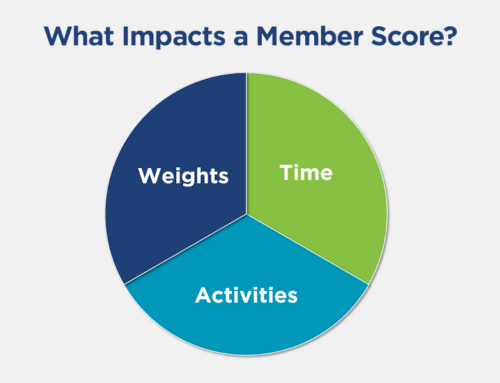Predictive analytics is one of the most promising technologies for data-driven associations today. This type of advanced analytics can be leveraged to provide real-time insights and predictions for future outcomes. By analyzing large volumes of historical data, associations can start to leverage artificial intelligence and predictive modeling to determine what is likely to happen in the future.
This type of analytics is now readily available for organizations of any size to enhance the member experience and grow profits. A great reason to start investing in predictive analytics is that it can be used to grow revenue at multiple stages of the customer lifecycle. We think of this in four stages:
- Converting new members
- Keeping members satisfied
- Upselling to current members
- Reducing member churn
This blog post will explore ideas on how you can leverage predictive analytics to gain more customers, optimize the member experience, upsell them on additional purchases, and ultimately reduce churn.
1. Converting new members
Membership and Marketing teams are focused on converting more non-members into paying customers. Predictive analytics can be a powerful way to improve conversion rates by grouping members by their propensity to convert – or in other words their propensity to buy.
By predicting which customers have the highest and lowest probability of converting, marketing teams can use this business intelligence to drive strategy and allocation of resources.
For example, many marketing teams run direct mail or other types of direct response campaigns to convert non-members into members. By using propensity modeling, your marketing team can go beyond segmentation and use predictive analytics to gain foresight into a customer’s likely actions.
Instead of sending that direct mail campaign to everyone on your list, you can use predictive analytics to improved targeted marketing efforts which will result in better conversions at a lower cost. Essentially, you are focusing your marketing spend on the customers that have the highest probability of converting.
2. Keeping members satisfied
Associations leaders are focused on delivering value to their members and have implemented strategic initiatives to optimize the member experience. Predictive analytics can be a part of your customer experience (CX) strategy, and many associations are starting to look at sentiment analysis to understand what members like or dislike about product and service offerings.
The idea is to analyze large volumes of unstructured data from online communities, social media, or direct feedback in surveys to understand member sentiment. This data can be insightful to help determine where members are finding value or where they get frustrated.
Using sentiment analysis allows you to understand how members feel in the present moment, so you can better predict how they will respond to future changes. For example, you might find that members are talking about one of your services as being valuable, but worry the cost may be too high. This might lead you to adjust pricing and bundling strategies to make the service more appealing to market needs.
By tapping into member sentiment, you get a real-time pulse into the effectiveness of your products and services. This can lead to improved pricing and go-to-market strategies, new product offerings that better fit member needs, and new opportunities to improve customer satisfaction.
The best way to improve the member experience is to listen closely to what customers are saying. Advanced analytics allows associations to do this at scale, taking large volumes of customer feedback and using it to guide strategy decisions.
3. Upselling to current members
Many associations are focused on driving non-dues revenue and have goals to upsell their current member base. This could be additional purchases, paid events, online courses, publications, and much more.
One application of advanced analytics is to build a recommendation engine that will help drive customer upsell. A recommendation engine seeks to predict the “rating” or “preference” a customer would give to an item, similar to how Amazon recommends what product to buy next.
Using artificial intelligence, associations can determine what members are likely to be interested in purchasing and this business intelligence can make customer upsell campaigns more successful. In other words, a recommendations engine can predict which products, content, or services a customer might also be interested in.
This allows your association to put relevant offers in front of interested customers and can have an impact on additional customer spend or engagement.
Many businesses are starting to incorporate this into their website strategy by using data and website personalization to display relevant content and offers that resonate with specific segments of their customer base.
4. Reducing member churn
Big data is helping businesses get a better idea of which customers are at risk of churn. Predictive analytics seeks to provide the business intelligence to know which members have the highest probability of churn, so that more resources can be allocated towards fighting it.
For members that have already churned, this same use case could apply for win-back campaigns to lapsed members. Looking at historical data, you can better predict which groups of lapsed members are most likely to renew their membership again. Your marketing team can then coordinate specific win-back campaigns that focus on these groups.
Both of these applications of predictive analytics can help improve retention over time, first by limiting churn and then by optimizing marketing campaigns to win-back customers. This can have a significant impact on overall profitability, with one article from HBR suggesting that “increasing customer retention rates by 5% increases profits by 25% to 95%.”
Of course, you should keep in mind that predictive analytics is not perfect when it comes to determining churn. You will need to consider changing market conditions and the economic factors that exist. While churn may be harder to predict, having robust data and analytics can be useful to supplement your team’s decision-making processes on how to optimize their resources to attain the best result.
The Predictive Toolkit
There’s a wide range of use cases that associations can start leveraging today. The predictive analytics toolkit includes things like propensity models, affinity analysis, market basket analysis, recommendation engines, sentiment analysis, decision trees, financial forecast models, and clustering. If you have large data sets and want to invest in the technology, it’s a great time to start leveraging predictive analytics to increase your customer lifetime value and to help guide your association’s internal planning, forecasting, and decision-making processes.



